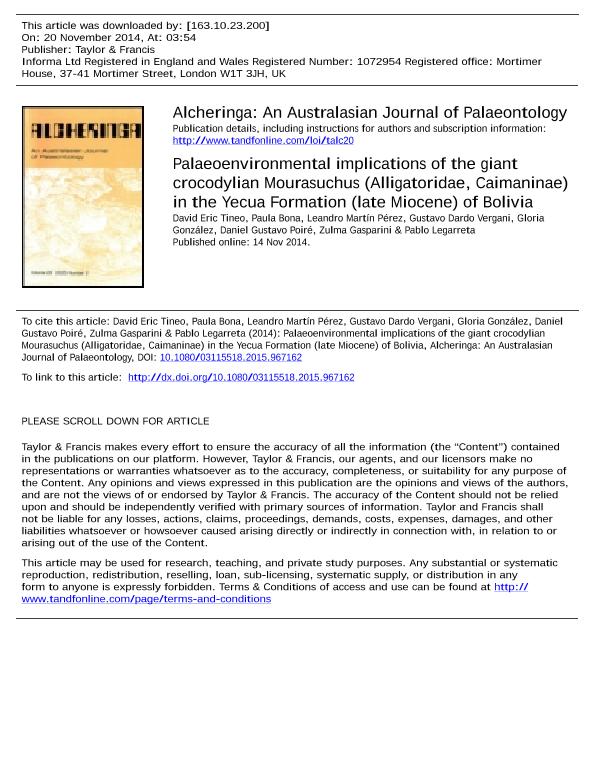Artículo
Outcrops of the Yecua Formation (late Miocene) are exposed for approximately 230 m along the La Angostura section of the Piraí River (50 km southwest of Santa Cruz de la Sierra). These reveal massive (argillic palaeosols) and laminated (quiet-water lacustrine and marsh settings) mudstones interbedded with thin sandstones containing microfossils, molluscs and vertebrate remains. Significantly, the succession hosts a giant crocodylian, Mourasuchus (Alligatoridae, Caimaninae), which is represented by both skull and postcranial fragments found in association with freshwater turtles and fishes. Mourasuchus was distributed widely from the middle Miocene of Colombia to upper Miocene of Venezuela, Brazil and Argentina, suggesting connections between major fluvial systems and an active mechanism for dispersal of South American freshwater vertebrates during the Miocene. 沿Pirai 河的La Angostura剖面Yecua组(晚中新世)的露头出露大约230米(Santa Cruz de la Sierra西南50公里)。这些露头显现出大量的(泥质古土壤)和层压的(静水湖泊和沼泽环境)泥岩,与薄砂层互层,后者含微化石、软体动物和脊椎动物的遗迹。重要的是,这些地层含有一个大型鳄鱼Mourasuchus(短吻鳄科,Caimaninae),其代表物是与淡水龟和淡水鱼共存的头骨和颅后碎片。 Mourasuchus广泛分布于哥伦比亚的中新世中期到委内瑞拉、巴西和阿根廷的上新世,说明中新世时主要河流系统的连通,及南美淡水脊椎动物的扩散机制。
Palaeoenvironmental implications of the giant crocodylian Mourasuchus (Alligatoridae, Caimaninae) in the Yecua Formation (late Miocene) of Bolivia
Tineo, David ; Bona, Paula
; Bona, Paula ; Pérez, Leandro Martín
; Pérez, Leandro Martín ; Vergani, Gustavo Dardo; González Rigas, Gloria; Poire, Daniel Gustavo
; Vergani, Gustavo Dardo; González Rigas, Gloria; Poire, Daniel Gustavo ; Brandoni, Zulma Nelida
; Brandoni, Zulma Nelida ; Legarreta, Pablo
; Legarreta, Pablo
 ; Bona, Paula
; Bona, Paula ; Pérez, Leandro Martín
; Pérez, Leandro Martín ; Vergani, Gustavo Dardo; González Rigas, Gloria; Poire, Daniel Gustavo
; Vergani, Gustavo Dardo; González Rigas, Gloria; Poire, Daniel Gustavo ; Brandoni, Zulma Nelida
; Brandoni, Zulma Nelida ; Legarreta, Pablo
; Legarreta, Pablo
Fecha de publicación:
11/2014
Editorial:
Taylor & Francis Ltd
Revista:
Alcheringa
ISSN:
0311-5518
Idioma:
Inglés
Tipo de recurso:
Artículo publicado
Clasificación temática:
Resumen
Archivos asociados
Licencia
Identificadores
Colecciones
Articulos(CCT - LA PLATA)
Articulos de CTRO.CIENTIFICO TECNOL.CONICET - LA PLATA
Articulos de CTRO.CIENTIFICO TECNOL.CONICET - LA PLATA
Citación
Tineo, David; González Rigas, Gloria; Pérez, Leandro Martín; Brandoni, Zulma Nelida; Poire, Daniel Gustavo; Bona, Paula; et al.; Palaeoenvironmental implications of the giant crocodylian Mourasuchus (Alligatoridae, Caimaninae) in the Yecua Formation (late Miocene) of Bolivia; Taylor & Francis Ltd; Alcheringa; 39; 2; 11-2014; 1-12
Compartir
Altmétricas



